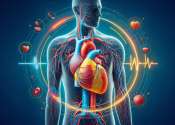Ischaemic or ischemic heart disease (IHD), or myocardial ischaemia, is a disease characterized by ischaemia (reduced blood supply) of the heart muscle, usually due to coronary artery disease (atherosclerosis of the coronary arteries). Its risk increases with age, smoking, hypercholesterolaemia (high cholesterol levels), diabetes, and hypertension (high blood pressure), and is more common in men and those who have close relatives with ischaemic heart disease.
Symptoms of stable ischaemic heart disease include angina (characteristic chest pain on exertion) and decreased exercise tolerance. Unstable IHD presents itself as chest pain or other symptoms at rest, or rapidly worsening angina. Diagnosis of IHD is with an electrocardiogram, blood tests (cardiac markers), cardiac stress testing or a coronary angiogram. Depending on the symptoms and risk, treatment may be with medication, percutaneous coronary intervention (angioplasty) or coronary artery bypass surgery (CABG).
It is the most common cause of death in most Western countries, and a major cause of hospital admissions. There is limited evidence for population screening, but prevention (with a healthy diet and sometimes medication for diabetes, cholesterol and high blood pressure) is used both to prevent IHD and to decrease the risk of complications.
The medical history distinguishes between various alternative causes for chest pain (such as dyspepsia, musculoskeletal pain, pulmonary embolism). As part of an assessment of the three main presentations of IHD, risk factors are addressed. These are the main causes of atherosclerosis (the disease process underlying IHD): age, male sex, hyperlipidaemia (high cholesterol and high fats in the blood), smoking, hypertension (high blood pressure), diabetes, and the family history.









